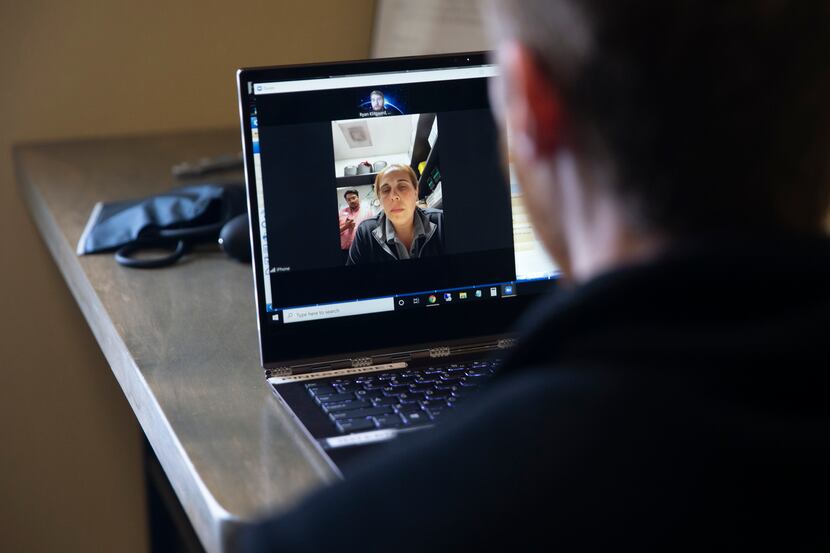AUSTIN — The use of telemedicine grew by leaps and bounds as COVID-19 forced people to stay home and avoid contact with others. Now, a Dallas lawmaker aims to continue the expanded use of the practice by guaranteeing the same reimbursement payments to medical professionals for these services as for in-person visits.
State Rep. Julie Johnson, D-Carrollton, said one of her legislative priorities for the session beginning in January will be writing into Texas law “pay parity” between in-person doctor visits and telemedicine appointments in state regulated health plans.
“This pandemic has forced physician groups to put telemedicine protocols in place,” she said. “It’s a benefit they’ve gotten used to and it’s one that we’re not going to want to lose.”
Under normal circumstances, telemedicine had not been widely used because people were slow to adopt it and regulatory barriers made it difficult for physicians to offer. But during COVID-19, state and federal officials granted waivers that made telemedicine more accessible.
Since then, the practice has caught on. Dr. Christopher Crow, chief executive of Plano-based Catalyst Health Network which serves 1.5 million people, said less than 1% of visits in the network before March were telemedicine appointments. But two weeks after the state entered a public health disaster because of the pandemic, nearly 99% of visits in the network were telemedicine appointments.
“The paradigm shift is like nothing I’ve ever witnessed,” Crow said. “Physicians liked it. Patients liked it. It makes total sense to lock this in as a paradigm for our society.”
But not everyone is on board with a requirement for pay parity. Jamie Dudensing, chief executive for the Texas Association of Health Plans, said such a change would amount to a state mandate imposed on health plans that have already worked out negotiated rates for services.
“This would be the first time that the Texas government would interfere with negotiated rates,” Dudensing said.
When the pandemic hit, her group was not opposed to the waivers that allowed for pay parity during a time of emergency. Those moves allowed for a quick way to subsidize providers when they otherwise would not be seeing patients or providing services.
But once the pandemic subsides, she said, pay parity should no longer be required.
“We don’t need to keep a system that subsidizes payments at extremely expensive rates when we’re not in an emergency,” Dudensing said.
“Some plans were doing payment parity before COVID and some will keep doing it after,” she added. “But it really should be a financial consideration that’s negotiated with providers the same way every other service is negotiated.”
Dudensing also said the bill does nothing to tackle other barriers to the wider adoption of telemedicine, like allowing federally qualified health centers to offer telemedicine services and letting out-of-state doctors practice in Texas. The pay parity requirement, she said, could harm the increased adoption of telemedicine in the state.
Tom Banning, chief executive of the Texas Association of Family Physicians, disagrees. He said telemedicine hasn’t been broadly adopted because the health care system disincentivizes patients from using the service with their regular physicians.
Health plans usually contract with a third-party provider to offer telemedicine services and agree on paying them a negotiated rate.
“Their utilization numbers are like 6%. Patients aren’t using them because they don’t know the doctor,” Banning said. “They don’t have a relationship with that physician. They don’t know if the doctor they’re presented with will fix their problem.”
By contrast, when patients went to their regular physicians for telemedicine visits after the COVID-19 rule changes, they were more comfortable with the practice. According to the Texas Association of Health Plans, more than 4.5 million Texans started using telehealth during the pandemic and 94% said they would continue using it after COVID-19.
Johnson, whose wife is a gastroenterologist, said she saw first-hand the benefits it offered patients. Instead of having to take a half day off work, a patient can schedule 15 minutes when they know they’ll have to check in with their physician about medication management or talk about refilling a prescription.
“It’s a win-win for physicians, patients and for our economy,” Johnson said. “It keeps people working.”
Physicians also liked it because they were guaranteed the same payment for a service as if it were offered in person.
“It removed those obstacles,” Banning said. “We have over the last eight months almost been experimenting on how telemedicine can best be utilized in terms of medical problems or clinical problems that would arise, without the concern of whether you’re going to get paid for that service or not.”
Banning said there are still questions about how to fully integrate telemedicine into medical practice. There are questions about how to manage the workflow between telemedicine and in-person appointments and some procedures can’t be done by teleconference, like drawing blood or testing for the flu or COVID-19.
But for services that can be offered through telemedicine, paying physicians the same rate for offering a service in a more convenient and cost-effective way is the right way to go, Banning said.
“It could be one of the most significant pieces of legislation that the Legislature takes on next session in terms of health care policy,” he said.
Dr. Thomas Kim, chief behavioral officer for Prism Health North Texas, said the bill’s main takeaway is to reaffirm that “telehealth is health care” and allow physicians like him to “be the right doctor at the right time” for patients in need.
“Nobody is forcing a payer to cover a service, but if you cover a service it should not matter whether it’s done conventionally or through telehealth,” Kim said.
Nicol Turner-Lee, a senior fellow of governance studies at the Brookings Institution who has done research on telehealth, said the steps taken after the pandemic could determine whether the practice continues its current use or is relegated to a second- or third-tier of service delivery.
“The question becomes will we find ourselves returning back to the normal doctor-patient care model that limits the use of telehealth for primary care services,” she said.
The adoption of pay parity could impact how health plans, which already have negotiated rates for telehealth services, react to the adoption of further telehealth services in their contracts.
“Our only concern is not the state parity law, it’s the extent to which we’ll see the reversal of progress on the adoption of telehealth that made it easier for people to get full-time care,” during the pandemic, Turner-Lee said.
Beyond pay parity, she said there are still other issues that stand in the way of wider adoption of telehealth services, such as limited broadband access in remote areas and concerns about privacy and fraud, that will have to be addressed after the pandemic.
But Dudensing said the bill would only apply to a limited number of patients. Most people get their health insurance from their employers, which would not be covered under the bill. Only about 17% of Texans get their health insurance from a state regulated health plan.

